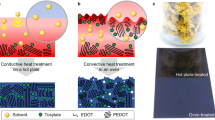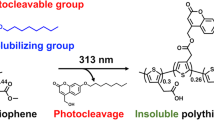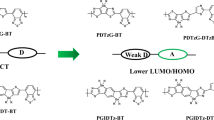Abstract
A copolymer based on 1,12-bis(carbazolyl)dodecane (2Cz-D) and 3,4-ethylenedioxythiophene (EDOT) was electrochemically synthesized in dichloromethane containing 0.1-M tetrabutylammonium tetrafluoroborate. Cyclic voltammetry, Fourier-transform infrared, morphological and elemental analyses confirm that the resultant polymer is a copolymer rather than a composite or a blend of the two homopolymers. The copolymer exhibits good redox activity and high electrochemical stability. In contrast with powdered poly(3,4-ethylenedioxythiophene) (PEDOT), the copolymer formed in this study exists in a free-standing film state, and it has a higher thermal stability and better mechanical properties. Moreover, the copolymer films emit blue light, depending on the monomer feed ratios. The thermoelectric properties of the copolymer films were also investigated. Because the 2Cz-D/EDOT feed ratios were different, the electrical conductivities of the obtained copolymer films were improved to varying degrees compared with that of the poly(1,12-bis(carbazolyl)dodecane) (P2Cz-D) film. The highest obtained electrical conductivity was 0.6 S cm−1, four orders of magnitude higher than that of P2Cz-D (2.7 × 10−5 S cm−1). The Seebeck coefficients of the copolymer films were also modified compared with that of P2Cz-D. All of these enhanced properties will be beneficial to the potential applications of these materials in polymer optoelectronics or as organic thermoelectric materials.
Similar content being viewed by others
Log in or create a free account to read this content
Gain free access to this article, as well as selected content from this journal and more on nature.com
or
References
Shirakawa, H., Louis, E. J., MacDiarmid, A. G., Chiang, C. K. & Heeger, A. J. Synthesis of electrically conducting organic polymers: halogen derivatives of polyacetylene, (CH)x . J. Chem. Soc. Chem. Commun. 16, 578–580 (1977).
Heeger, A. J. Semiconducting and metallic polymers: the fourth generation of polymeric materials. J. Phys. Chem. B 105, 8475–8491 (2001).
MacDiarmid, A. G. Synthetic metals: a novel role for organic polymers. Synth. Met. 125, 11–22 (2002).
Udum, Y. A., Ergun, Y., Sahin, Y., Pekmez, K. & Yildiz, A. Electrochemical synthesis and characterization of a new soluble conducting polymer. J. Mater. Sci. 44, 3148–3155 (2009).
Winder, C. & Sariciftci, N. S. Low bandgap polymers for Photon Harvesting in bulk heterojunction solar cells. J. Mater. Chem. 14, 1077–1086 (2004).
Kim, Y. G., Thompson, B. C., Ananthakrishnan, N., Padmanaban, G., Ramakrishnan, S. & Reynolds, J. R. Variable band gap conjugated polymers for optoelectronic and redox applications. J. Mater. Res. 20, 3188–3198 (2005).
Reddinger, J. L., Sotzing, G. A. & Reynolds, J. R. Muticoloured electrochromic polymers derived from easily oxidized bis[2-(3,4-ethylenedioxy)thienyl]carbazoles. Chem. Commun. 15, 1777–1778 (1996).
Pickup, D. F., Yi, H. N. & Iraqi, A. Preparation and properties of alternating 2,7-linked carbazole copolymers with phenylene units with varying number of fluorine substituents. J. Mater. Sci. 44, 3172–3178 (2009).
Low, P. J., Paterson, M. A. J., Yufit, D. S., Howart, J. A. K., Cherryman, J. C., Tackley, D. R., Brook, R. & Brown, B. Towards an understanding of structure–property relationships in hole-transport materials: the influence of molecular conformation on oxidation potential in poly(aryl)amines. J. Mater. Chem. 15, 2304–2315 (2005).
MacClenaghan, N. D., Passalacqua, R., Loiseau, F., Campagna, S., Verheyde, B., Hameurlaine, A. & Dehaen, W. Ruthenium(II) dendrimers containing carbazole-based chromophores as branches. J. Am. Chem. Soc. 125, 5356–5365 (2003).
Trannekar, P., Fulghum, T., Baba, A., Patton, D. & Advincula, R. Quantitative electrochemical and electrochromic behavior of terthiophene and carbazole containing conjugated polymer network film precursors: EC-QCM and EC-SPR. Langmuir 23, 908–917 (2007).
Grazulevicius, J. V., Strohriegl, P., Pelichowski, J. & Pelichowski, K. Carbazole-containing polymers: synthesis, properties and applications. Prog. Polym. Sci. 28, 1297–1353 (2003).
Grigoras, M. & Antonia, N. C. Synthesis and characterization of some carbazole-based imine polymers. Eur. Polym. J. 41, 1079–1089 (2005).
Kimoto, A., Cho, J. S., Higuchi, M. & Yamamoto, K. Synthesis of asymmetrically arranged dendrimers with a carbazole dendron and a phenylazomethine dendron. Macromolecules 37, 5531–5537 (2004).
Bloudin, N. & Leclerc, M. Poly(2,7-carbazole)s: structureproperty relationships. Acc. Chem. Res. 41, 1110–1119 (2008).
Watanabe, M., Nishiyama, M., Yamamoto, T. & Koie, Y. Palladium/P(t-Bu)3-catalyzed synthesis of N-aryl azoles and application to the synthesis of 4,4′,4″-Tris(N-azolyl)triphenylamines. Tetrahedron Lett. 41, 481–483 (2000).
Koyuncu, S., Gultekin, B., Zafer, C., Bilgili, H., Can, M., Demic, S., Kay, I. & Icli, S. Electrochemical and optical properties of biphenyl bridged-dicarbazole oligomer films: electropolymerization and electrochromism. Electrochim. Acta 54, 5694–5702 (2009).
Chen, J. P. & Natansohn, A. Synthesis and characterization of novel carbazole-containing soluble polyimides. Macromolecules 32, 3171–3177 (1999).
Qu, J., Kawasaki, R., Shiotsuki, M., Sonda, F. & Masuda, T. Synthesis and properties of polyacetylenes carrying N-phenylcarbazole and triphenylamine moieties. Polymer 47, 6551–6559 (2006).
Clouted, E., Olivero, C., Ades, D., Castex, M. C. & Siove, A. Synthesis and blue luminescence of a soluble newly designed carbazole main-chain polymer. Polymer 43, 3489–3495 (2002).
Cosnier, S., Fologea, D., Szunerits, S. & Marks, R. S. Poly(dicarbazole-N-hydroxysuccinimide) film: a new polymer for the reagentless grafting of enzymes and redox mediators. Electrochem. Commun. 2, 827–831 (2000).
Marrec, P., Dano, C., Gueguen-Simonet, N. & Simonet, J. The anodic oxidation and polymerization of carbazoles and dicarbazoles N-substituted by polyether chains. Synth. Met. 89, 171–179 (1997).
Cosnier, S., Lepellec, A., Marks, R. S., Perie, K. & Lellouche, J. P. A permselective biotinylated polydicarbazole film for the fabrication of amperometric enzyme electrodes. Electrochem. Commun. 5, 973–977 (2003).
Diamant, Y., Furmanovich, E., Landau, A., Lellouche, J. P. & Zaban, A. Electrochemical polymerization and characterization of a functional dicarbazole conducting polymer. Electrochim. Acta 48, 507–512 (2003).
Wei, Z. H., Wang, Q., Xu, J. K., Nie, Y. L., Du, Y. K. & Xia, H. Y. Facile electrosyntheses of high tensile strength alkyl-bridged dicarbazole polymer films and its fluorescence Spectra. J. Polym. Sci. Part A Polym. Chem. 46, 5232–5241 (2008).
Jia, P., Xu, J., Ma, J. & Lu, X. Enhancement of electrochromic contrast by tethering polyaniline onto cyclotriphosphazene. Eur. Polym. J. 45, 772–778 (2009).
Ma, L., Li, Y., Yu, X., Yang, Q. & Noh, C. Fabricating red–blue-switching dual polymer electrochromic devices using room temperature ionic liquid. Sol. Energy Mater. Sol. Cells 93, 564–570 (2009).
Ak, M., Şahmetlioǧlu, E. & Toppare, L. Synthesis, characterization and optoelectrochemical properties of poly(1,6-bis(2,5-di(thiophen-2-yl)-1H-pyrrol-1-yl)hexane) and its copolymer with EDOT. J. Electroanal. Chem. 621, 55–61 (2008).
Berlin, A., Zotti, G., Zecchin, S., Schiavon, G., Vercelli, B. & Zanelli, A. New low-gap polymers from 3,4-ethylenedioxythiophene-bis-substituted electron-poor thiophenes. The roles of thiophene, donor-acceptor alternation, and copolymerization in intrinsic Conductivity. Chem. Mater. 16, 3667–3676 (2004).
Yildiz, E., Camurlu, P., Tanyeli, C., Akhmedov, I. & Toppare, L. A soluble conducting polymer of 4-(2,5-di(thiophen-2-yl)-1H-pyrrol-1-yl)benzenamine and its multichromic copolymer with EDOT. J. Electroanal. Chem. 612, 247–256 (2008).
Zhang, C., Hua, C., Wang, G. H., Ouyang, M. & Ma, C. A. A novel multichromic copolymer via electrochemical copolymerization of (S)-1,1′-binaphthyl-2,2′-diyl bis(N-(6-hexanoic acid-1-yl) pyrrole) and 3,4-ethylenedioxythiophene. Electrochim. Acta 55, 4103–4111 (2010).
Wagner, K., Pringle, J. M., Hall, S. B., Forsyth, M., Macfarlene, D. R. & Officer, D. L. Investigation of the electropolymerisation of EDOT in ionic liquids. Synth. Met. 153, 257–260 (2005).
Raimundo, J. M., Blanchard, P., Frere, P., Mercier, N., Ledoux, R. I., Hierle, R. & Roncali, J. Push-pull chromophores based on 2,2′-bi(3,4-ethylenedioxythiophene) (BEDOT) π-conjugating spacer. Tetrahedron Lett. 42, 1507–1510 (2001).
Walczak, R. M., Cowart, J. S., Abboud, K. A. & Reynolds, J. R. Conformational locking for band gap control in 3,4-propylenedioxythiophene based electrochromic polymers. Chem. Commun. 15, 1604–1606 (2006).
Li, Y., Ding, J., Day, M., Tao, Y., Lu, J. & Diorio, M. Synthesis and properties of random and alternating fluorene/carbazole copolymers for use in Blue light-emitting devices. Chem. Mater. 16, 2165–2173 (2004).
Li, X. G., Huang, M. R., Duan, W. & Yang, Y. L. Novel multifunctional polymers from aromatic diamines by oxidative polymerizations. Chem. Rev. 102, 2925–3030 (2002).
Otero, T. F. & Larreta-Azelain, E. D. Electrochemical generation of polythiophene films on platinum electrodes. Polymer 29, 1522–1527 (1988).
Morin, J. F., Leclerc, M., Ades, D. & Siove, A. Polycarbazoles: 25 years of progress. Macromo. Rapid Commun. 26, 761–778 (2005).
Innis, P. C., Mazurkiewicz, J., Nguyen, T., Wallace, G. G. & Macfarlane, D. Enhanced electrochemical stability of polyaniline in ionic liquids. Curr. Appl. Phys. 4, 389–393 (2004).
Li, M. C., Ma, C. A., Liu, B. Y. & Jin, Z. M. A novel electrolyte 1-ethylimidazolium trifluoroacetate used for electropolymerization of aniline. Electrochem. Commun. 7, 209–212 (2005).
Kumar, A., Welsh, D. M., Morvant, M. C., Piroux, F., Abboud, K. A. & Reynolds, J. R. Conducting poly(3,4-alkylenedioxythiophene) derivatives as fast electrochromics with high-contrast ratios. Chem. Mater. 10, 896–902 (1998).
Hiroshige, Y., Ookawa, M. & Toshima, N. High thermoelectric performance of poly(2,5-dimethoxyphenylenevinylene) and its derivatives. Synth. Met. 156, 1341–1347 (2006).
Lévesque, I., Gao, X., Klug, D. D., Tse, J. S., Ratcliffe, C. I. & Leclerc, M. Highly soluble poly(2,7-carbazolenevinylene) for thermoelectrical applications: from theory to experiment. React. Funct. Polym. 65, 23–36 (2005).
Acknowledgements
NSFC (50963002&51073074) and Key Laboratory of Photochemical Conversion and Optoelectronic Materials, TIPC, CAS are acknowledged for their financial supports.
Author information
Authors and Affiliations
Corresponding author
Additional information
Supplementary Information accompanies the paper on Polymer Journal website
Supplementary information
Rights and permissions
About this article
Cite this article
Yue, R., Lu, B., Xu, J. et al. Electrochemistry, morphology, thermoelectric and thermal degradation behaviors of free-standing copolymer films made from 1,12-bis(carbazolyl)dodecane and 3,4-ethylenedioxythiophene. Polym J 43, 531–539 (2011). https://doi.org/10.1038/pj.2011.26
Received:
Revised:
Accepted:
Published:
Issue date:
DOI: https://doi.org/10.1038/pj.2011.26
Keywords
This article is cited by
-
Hybrid π-conjugated polymers from dibenzo pentacyclic centers: precursor design, electrosynthesis and electrochromics
Science China Chemistry (2017)
-
Electrochemical and chemical investigations of the co-polymers of 3-aminobenzenesulfonic acid with aromatic amines for their application in electrochromic devices
Journal of Applied Electrochemistry (2012)



